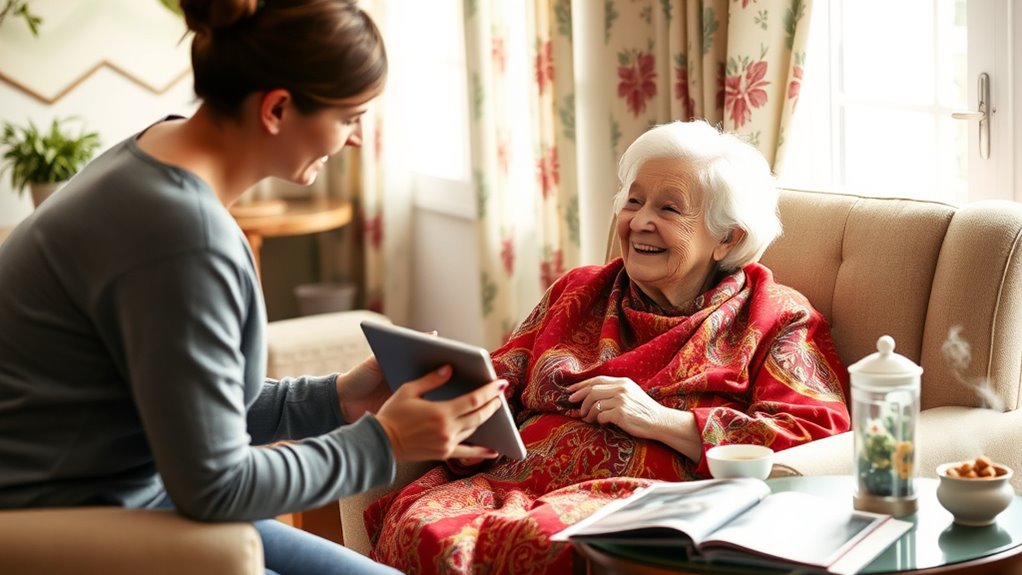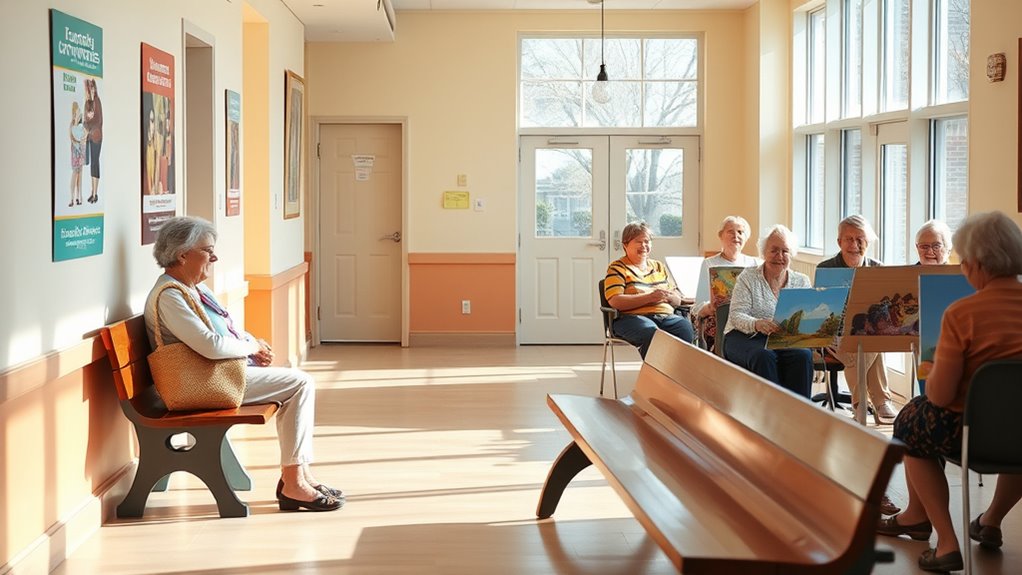To help elderly adults cope with isolation, encourage regular social interactions through community activities, hobbies, and digital communication tools. Foster strong support from family, friends, and caregivers, and create a safe, comfortable home environment. Promote engagement in mental and physical activities to boost well-being and reduce loneliness. Incorporating technology like video calls and online groups can make a big difference. Keep exploring ways to strengthen their connections and support their independence for a happier, healthier life.
Key Takeaways
- Encourage regular social interactions through community events, family visits, and digital communication tools.
- Promote cognitive activities like puzzles and hobbies to maintain mental sharpness.
- Foster a supportive environment by implementing safety measures and home modifications.
- Use technology such as video calls and online groups to combat loneliness and strengthen connections.
- Engage in physical and mental wellness routines tailored to individual interests and abilities.
Understanding the Impact of Isolation on Elderly Well-being

Isolation can profoundly harm the well-being of elderly adults, affecting both their physical and mental health. When you’re isolated, your emotional resilience takes a hit, making it harder to cope with daily stresses. It also diminishes cognitive stimulation, which is vital for maintaining mental sharpness. Without regular social and mental engagement, your brain can start to decline faster, increasing the risk of memory loss and other cognitive issues. You may also feel more anxious, depressed, or lonely, which further worsens your overall health. Recognizing these impacts helps you understand why addressing isolation is essential. Strengthening emotional resilience and finding ways to keep your mind active are key steps in protecting your well-being. Taking proactive measures can help you maintain a healthier, more connected life despite the challenges of aging. Additionally, understanding the importance of cognitive stimulation can guide efforts to keep the mind engaged and healthy. Incorporating activities such as mental exercises or puzzles can provide meaningful engagement and support cognitive health. Engaging in social activities can also combat loneliness and promote emotional well-being. Exploring support networks or community groups can further enhance social interaction and emotional support, especially when considering the benefits of social engagement supported by research.
Encouraging Regular Social Interaction and Engagement

Encouraging your elderly loved ones to participate in community activities can help reduce feelings of isolation. You can also introduce them to digital tools like video calls and social media to stay connected. These approaches make social interaction more accessible and enjoyable for seniors. Additionally, exploring electric bike options can promote outdoor activity and independence for seniors who are able to ride. Engaging in community involvement can further enhance their sense of belonging and purpose. Furthermore, understanding the importance of social engagement can motivate seniors to seek out and participate in various activities that promote mental and emotional well-being. As an additional benefit, choosing vacuum cleaners for pet hair can help maintain a clean and allergen-reduced environment, which is especially beneficial for seniors with sensitivities. Emphasizing the importance of breakfast delivery options, which are increasingly popular and convenient, can also provide seniors with nutritious meals that support their health and well-being.
Promote Community Activities
Engaging elderly adults in community activities can considerably reduce feelings of loneliness and foster a sense of belonging. Encourage participation in local clubs and hobby groups tailored to their interests. These activities offer regular social interaction and help build new friendships. Consider involving them in community events, volunteer opportunities, or neighborhood gatherings. To visualize, here’s a sample of options:
| Activity Type | Examples | Benefits |
|---|---|---|
| Hobby Groups | Book clubs, gardening groups | Stimulate minds, share passions |
| Local Clubs | Senior centers, sports clubs | Physical activity, social bonds |
| Community Events | Fairs, cultural festivals | Cultural engagement, fun |
| Volunteer Opportunities | Food banks, mentoring | Purposeful engagement |
Promoting these activities keeps elderly adults active, connected, and engaged in their community. Engaging in social engagement can also improve their overall well-being and quality of life. Participating in community involvement can provide a sense of purpose and belonging that greatly enhances their mental health. Supporting community resources can further facilitate access to these activities and ensure ongoing participation. Additionally, fostering intergenerational connections can enrich their social experience and bring fresh perspectives. Recognizing the importance of spiritual well-being can also aid in creating more holistic approaches to elderly care.
Leverage Digital Communication
Digital communication offers a practical way to help elderly adults stay socially connected, especially when in-person interactions are limited. By embracing virtual friendships, they can maintain meaningful relationships with family, friends, or new acquaintances without leaving home. Encouraging online hobbies, like virtual book clubs or gardening groups, provides engaging activities that foster regular interaction. These digital connections reduce feelings of loneliness and isolation, giving seniors a sense of belonging. You can help them set up user-friendly devices or introduce them to simple platforms, making online communication less intimidating. Understanding industry trends can help tailor digital engagement strategies effectively. Additionally, staying informed about vetted resources for elderly communication can enhance the quality and safety of their online interactions. Incorporating AI-powered tools can further personalize and improve their online experience. Utilizing accessible technology designed specifically for seniors can make digital communication even more intuitive and enjoyable. Implementing AI security measures ensures that their online interactions remain safe and protected from cyber threats. Leveraging digital communication ensures that elderly adults stay active, engaged, and emotionally connected despite physical distance.
Leveraging Technology to Stay Connected

Technology offers powerful tools for seniors to stay connected with loved ones and the community. Using video calls, messaging apps, and online platforms, you can maintain close relationships and reduce feelings of isolation. Virtual companionship services provide friendly interactions, helping you feel less lonely. Online support groups connect you with others facing similar challenges, offering emotional support and shared experiences. Here’s a quick comparison:
| Benefit | How It Helps |
|---|---|
| Virtual Companionship | Provides friendly interaction |
| Online Support Groups | Connects you with peers for support |
Furthermore, leveraging AI technology can enhance these connections by offering personalized interactions and assistance. Incorporating digital literacy skills can also empower seniors to navigate these tools confidently, further reducing feelings of loneliness. Additionally, user-friendly interfaces can make it easier for seniors to access and utilize these digital tools effectively. Developing accessible design in digital platforms ensures that seniors with varying abilities can benefit from these technologies.
Participating in Community Activities and Programs

Participating in community activities and programs offers a great way to stay socially active and connected. Engaging in local volunteer programs allows you to give back while meeting others who share your interests. These programs often provide a sense of purpose and belonging, reducing feelings of isolation. Attending neighborhood events, such as fairs or group outings, encourages interaction with neighbors and helps build new friendships. Many communities organize senior-friendly activities that cater specifically to your needs and preferences. By actively participating, you create opportunities for meaningful connections and stay engaged in your community. Leveraging efficient general ledger coding can also support local organizations in managing their resources effectively, further strengthening community ties. These simple steps can markedly improve your emotional well-being and help you feel more included, making your daily life more fulfilling and less lonely.
Creating a Supportive Home Environment

Creating a supportive home environment is a vital step in combating isolation among elderly adults. Start by evaluating your loved one’s living space through safety assessments to identify potential hazards. Home modifications can make the environment safer and more accessible, such as installing grab bars, improving lighting, or removing clutter. These changes not only reduce the risk of falls but also boost confidence, encouraging more independence. Keep pathways clear and consider adding non-slip mats in key areas like the bathroom and kitchen. A comfortable, secure environment creates peace of mind and encourages social engagement. Regularly review the home’s safety features to adapt to changing needs. By making thoughtful home modifications, you help your loved one feel safer, more comfortable, and less isolated.
Enlisting Help From Family, Friends, and Caregivers

Reaching out to family, friends, and caregivers is essential to build a strong support network for your loved one. Clear communication helps everyone understand needs and preferences, ensuring they feel valued and included. Together, you can create a reliable system that reduces isolation and promotes well-being.
Building Support Networks
Building a strong support network is essential for helping elderly adults combat feelings of isolation. It creates emotional bonds and offers peer support that boosts their well-being. To build this network, consider:
- Reach out regularly to family and friends to reinforce emotional bonds.
- Encourage participation in community groups or senior centers to foster peer support.
- Involve caregivers who can provide consistent assistance and companionship.
- Use technology like video calls to stay connected when in-person visits aren’t possible.
Effective Communication Strategies
Effective communication is essential when enlisting help from family, friends, and caregivers to support an elderly adult. Pay attention to non-verbal cues like facial expressions, gestures, and eye contact, which often reveal feelings words can’t express. Use active listening by giving your full attention, nodding, and providing verbal affirmations to show you’re engaged. This encourages the elderly person to open up and share their concerns. Avoid interrupting, and clarify what you hear to ensure understanding. When you combine active listening with awareness of non-verbal cues, you create a safe environment that fosters trust. Clear, compassionate communication helps the elderly adult feel valued and supported, making it easier to address their needs and reduce feelings of isolation effectively.
Promoting Mental and Physical Health Through Activities

Engaging in various activities can substantially boost both mental and physical health in elderly adults. Active participation keeps the mind sharp and the body strong. To enhance well-being, consider these activities:
- Practice mindfulness exercises daily to reduce stress and improve mental clarity.
- Incorporate regular physical activity, like walking or gentle stretching, to boost physical health.
- Focus on nutritional planning by preparing balanced meals that support energy and immunity.
- Engage in social activities or hobbies to foster a sense of purpose and connection.
These approaches help combat isolation, promote resilience, and improve overall quality of life. Consistency is key—small, regular steps can make a significant difference in maintaining health and happiness as you age.
Developing Personalized Strategies to Combat Loneliness

After incorporating activities that support mental and physical health, the next step is to tailor strategies specifically to each individual’s needs and preferences. You can achieve this through personalized activities that resonate with their interests and history. By understanding what brings them joy, you provide customized support that encourages engagement and connection. For example, if they enjoy gardening, suggest setting up a small outdoor space or virtual plant care groups. If they love music, arrange virtual concerts or sing-alongs. The key is to listen actively and adapt your approach to fit their unique personalities. Personalized activities foster a sense of purpose and belonging, reducing feelings of loneliness. This targeted approach helps create a supportive environment where your loved one feels valued and understood.
Frequently Asked Questions
How Can I Identify Signs of Severe Loneliness in Elderly Adults?
You can spot severe loneliness in elderly adults by paying attention to emotional cues like persistent sadness, anxiety, or irritability. Behavioral changes such as withdrawal from social activities, neglecting personal care, or a sudden lack of interest in hobbies also indicate loneliness. If you notice these signs, it’s essential to engage with empathy and encourage social connections, as addressing emotional and behavioral cues can markedly improve their well-being.
What Are Effective Ways to Motivate Isolated Seniors to Seek Help?
To motivate isolated seniors to seek help, you can use motivational interviewing techniques that gently explore their feelings and encourage change. Show empathy and listen actively, making them feel understood. Additionally, introduce peer support programs where they connect with others who share similar experiences. These approaches build trust and reduce stigma, making seniors more comfortable in accepting assistance and seeking help to improve their well-being.
How Does Social Isolation Affect Elderly Physical Health Risks?
Social isolation critically increases health risks for the elderly. It can lead to poor mental health, including depression and anxiety, and accelerates cognitive decline. When you’re isolated, you may neglect physical activity and proper nutrition, raising the chances of chronic illnesses. Recognizing these risks helps you understand why staying socially connected is essential for maintaining your overall health, mental well-being, and cognitive sharpness as you age.
Are There Specific Hobbies That Help Reduce Feelings of Loneliness?
Did you know that engaging in group activities and creative hobbies can cut loneliness by nearly 30%? You can reduce feelings of loneliness by joining local clubs, such as art classes, book groups, or gardening groups. Creative hobbies like painting, knitting, or playing music also foster connection and purpose. These activities boost your mood, keep your mind active, and help you build meaningful relationships, making social isolation much easier to overcome.
How Can Communities Better Support Socially Isolated Elderly Residents?
To better support socially isolated elderly residents, you should promote community outreach initiatives that connect them with local resources and social activities. Volunteer programs are essential; they provide companionship and help reduce loneliness. Encourage community members to participate actively, visiting seniors regularly or offering assistance. By fostering inclusive environments and building strong social networks, you help elderly residents feel valued, engaged, and less isolated.
Conclusion
Remember, overcoming isolation is like tending a garden—you need consistent care, attention, and the right environment for growth. By staying connected, embracing technology, and seeking support, you nurture your well-being and help your happiness flourish. Don’t wait for the weeds of loneliness to take over; take proactive steps today. Your social garden thrives with effort, and the beauty of connection can blossom into a vibrant, fulfilling life.









